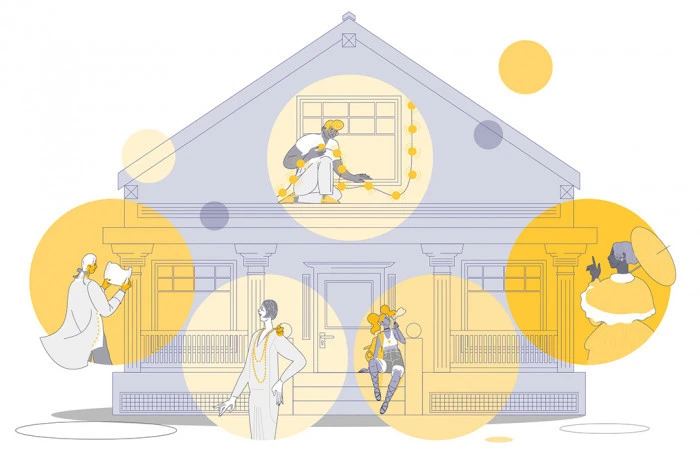Share what you know,
and discover more.
Share what you know,
and discover more.
May 15, 2023
May 15, 2023
1303 S. Wiggins Springfield, IL 62704
Original Owner: Compton, Dr. Charles,Architect: Helmle & Helmle
Posted Date
May 15, 2023
Historical Record Date
May 15, 2023
Source Name
Brick Story
Source Website
Delete Story
Are you sure you want to delete this story?
Jun 15, 2017
Jun 15, 2017

-

- Charmaine Bantugan
Dr. Charles Compton House
The Dr. Charles Compton House is a historic house located at 1303 South Wiggins Avenue in the Oak Knolls neighborhood of Springfield, Illinois. The house was built in 1926 for Dr. Charles Wentworth Compton, a local surgeon and the founder of local political group the Wentworth Republicans. Springfield architects Helmle and Helmle designed the Tudor Revival house, which was one of their many works in Oak Knolls. The house's front facade features a variety of materials and textures. The main entrance has its own roof and neighbors a stone tower with a parapet. The front of the house has a projecting gable on either side of the door; one gable is stucco with brick-edged windows, while the other matches the rest of the front facade, with brick on the first floor and stucco half-timbering on the second. The original slate roof of the house is broken by two brick chimneys. The house was added to the National Register of Historic Places on May 8, 2017.
Dr. Charles Compton House
The Dr. Charles Compton House is a historic house located at 1303 South Wiggins Avenue in the Oak Knolls neighborhood of Springfield, Illinois. The house was built in 1926 for Dr. Charles Wentworth Compton, a local surgeon and the founder of local political group the Wentworth Republicans. Springfield architects Helmle and Helmle designed the Tudor Revival house, which was one of their many works in Oak Knolls. The house's front facade features a variety of materials and textures. The main entrance has its own roof and neighbors a stone tower with a parapet. The front of the house has a projecting gable on either side of the door; one gable is stucco with brick-edged windows, while the other matches the rest of the front facade, with brick on the first floor and stucco half-timbering on the second. The original slate roof of the house is broken by two brick chimneys. The house was added to the National Register of Historic Places on May 8, 2017.
Dr. Charles Compton House
The Dr. Charles Compton House is a historic house located at 1303 South Wiggins Avenue in the Oak Knolls neighborhood of Springfield, Illinois. The house was built in 1926 for Dr. Charles Wentworth Compton, a local surgeon and the founder of local political group the Wentworth Republicans. Springfield architects Helmle and Helmle designed the Tudor Revival house, which was one of their many works in Oak Knolls. The house's front facade features a variety of materials and textures. The main entrance has its own roof and neighbors a stone tower with a parapet. The front of the house has a projecting gable on either side of the door; one gable is stucco with brick-edged windows, while the other matches the rest of the front facade, with brick on the first floor and stucco half-timbering on the second. The original slate roof of the house is broken by two brick chimneys.The house was added to the National Register of Historic Places on May 8, 2017.
Posted Date
Aug 23, 2022
Historical Record Date
Jun 15, 2017
Source Name
Wikipedia
Source Website
Delete Story
Are you sure you want to delete this story?
May 08, 2017

-

- Charmaine Bantugan
National Register of Historic Places - Dr. Charles Compton House
Statement of Significance: The Compton House is an excellent example of Tudor Revival architecture in Springfield and is therefore eligible for listing under Criteria C of the National Register at a local level of significance. The Compton House is a showplace for the Tudor Revival style typical of residences built during the Eclectic Period of architecture during the 1920’s and 1930’s. The two and half story home’s dominant roofline is composed of original slate shingles, front facing gables, steep pitches, and massive chimneys. The exterior’s surface displays elements characteristic of the Tudor Revival style with a mix of false half-timbers, stucco, brick, and stone. The interior features beams, Tudor arches, original wood and tile floors, radiators, bookcases and light fixtures. Additionally, the home’s location and orientation, across the street from a National Register historic district, ensures the integrity of the view shed and reinforces the importance of the home’s preservation. Consequently, the Compton House has sufficient integrity to be listed.
National Register of Historic Places - Dr. Charles Compton House
Statement of Significance: The Compton House is an excellent example of Tudor Revival architecture in Springfield and is therefore eligible for listing under Criteria C of the National Register at a local level of significance. The Compton House is a showplace for the Tudor Revival style typical of residences built during the Eclectic Period of architecture during the 1920’s and 1930’s. The two and half story home’s dominant roofline is composed of original slate shingles, front facing gables, steep pitches, and massive chimneys. The exterior’s surface displays elements characteristic of the Tudor Revival style with a mix of false half-timbers, stucco, brick, and stone. The interior features beams, Tudor arches, original wood and tile floors, radiators, bookcases and light fixtures. Additionally, the home’s location and orientation, across the street from a National Register historic district, ensures the integrity of the view shed and reinforces the importance of the home’s preservation. Consequently, the Compton House has sufficient integrity to be listed.
May 08, 2017
National Register of Historic Places - Dr. Charles Compton House
Statement of Significance:The Compton House is an excellent example of Tudor Revival architecture in Springfield and is therefore eligible for listing under Criteria C of the National Register at a local level of significance. The Compton House is a showplace for the Tudor Revival style typical of residences built during the Eclectic Period of architecture during the 1920’s and 1930’s. The two and half story home’s dominant roofline is composed of original slate shingles, front facing gables, steep pitches, and massive chimneys. The exterior’s surface displays elements characteristic of the Tudor Revival style with a mix of false half-timbers, stucco, brick, and stone. The interior features beams, Tudor arches, original wood and tile floors, radiators, bookcases and light fixtures. Additionally, the home’s location and orientation, across the street from a National Register historic district, ensures the integrity of the view shed and reinforces the importance of the home’s preservation. Consequently, the Compton House has sufficient integrity to be listed.
Posted Date
Aug 23, 2022
Historical Record Date
May 08, 2017
Source Name
National Register of Historic Places
Source Website
Delete Story
Are you sure you want to delete this story?



















